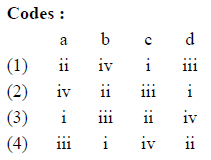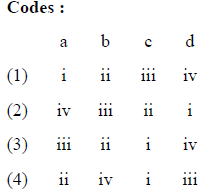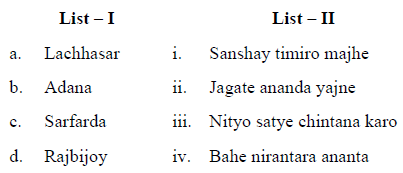RABINDRA SANGIT
PAPER – III
Note : This paper contains seventy five (75) objective type questions of two (2) marks each. All questions are compulsory.
1. Identify the raga of the song ‘Bipula Taronga Re’
(1) Purabi
(2) Bhimpalasree
(3) Imankalyan
(4) Tori
2. Which one of the following songs is tuned in ‘Sindhu’ ?
(1) Pipasa hai nahi mitilo
(2) Chiro sakha, chero na more
(3) Sada thako Anande
(4) Ke basile aji hridayasthane
3. ‘Prabhater Adim Abhas Arunbarna Abhar Abarane’
Trace out the source
(1) Chandalika
(2) Chitrāngada
(3) Shapmochan
(4) Shyama
4. “Deko na amare, deko na …” belongs to the category
(1) Puja
(2) Bichitra
(3) Prem
(4) Swadesh
5. ‘Basante basante tomar kobire dao dak’ is from
(1) Phalguni
(2) Nataraj riturangasala
(3) Nabin
(4) Muktadhara
6. The song sung by Satyajit Ray himself in his film Agantuk :
(1) E parabase robe ke
(2) Bajilo kahara bina
(3) Andhojane deho alo
(4) Thora pata go
7. How does ‘Tomar asime’ deviate from Behag ?
By the use of :
(1) Komal Dhaibat
(2) Komal Nishad
(3) Komal Rishabh
(4) Komal Gazdhar
8. Who played the veena along with singing ?
(1) Santi Dev Ghosh
(2) Pankaj Kumar Mallik
(3) Anadi Kumar Dastidar
(4) Shailajaranjan Mazumdar
9. Which song was composed by Tagore to celebrate the harvest ceremony ?
(1) O amar desher mati
(2) Eso shyamolo sundar
(3) Aay re mora phasal kati
(4) Amar praner pare
10. ‘Srabonor borisona par hoye ki bani’ was written when Rabindranath Tagore was
(1) 58
(2) 38
(3) 33
(4) 63
11. Raga and tala of ‘Majhe majhe taba dekha’ –
(1) Bilabal/Dadra
(2) Kafi/Ektal
(3) Bhupali/Dadra
(4) Todi/Rupakra
12. ‘Rabirashmi’ is written by
(1) Nihar Ranjan Roy
(2) Sarala Devi
(3) Prasanta Kumar Pal
(4) Charuchandra Bandyopadhyay
13. “Ogo tomra Sabai bhalo” occurs in
(1) Raja o Rani
(2) Goray galad
(3) Sonar tari
(4) Chitra
14. ‘Ei tomari milano sudha roilo prane sanchita’ – this line is from the song
(1) Preme prane gane gandhe
(2) Amar bela je jay
(3) Ei labhinu sango tabo
(4) Ohe sundaro mano
15. The number of songs in ‘Prarthana’ is
(1) 59
(2) 10
(3) 36
(4) 143
16. From ‘Nitu charano mule’ – Tagore composed the song :
(1) Yao re anantodhame
(2) Nomi nomi bharoti
(3) Baje karuna sure
(4) Eso shyamal sundar
17. What was Tagore’s age when he composed the song ‘Matrimandir punya Angana’ ?
(1) 52
(2) 76
(3) 56
(4) 53
18. “Yogi he, yogi he, ke tumi hridi-asane” in Kedar, Ektal occurs in the play …..
(1) Prakritir Pratishodh
(2) Guru
(3) Achalayatan
(4) Chirakumar Sabha
19. Who edited Tagore’s posthumous publication Sangit-Chinta ?
(1) Santideb Ghosh
(2) Indira Debi Chaudhurani
(3) Pramatha Chaudhuri
(4) Pulinbihari Sen
20. “Shudhu tomar vani nay go he bandhu, he priya” occurs in
(1) gitali
(2) gitimalya
(3) utsarga
(4) naivedya
21. Where do you find the monsoon composition “Aowe piarawa, rimijhimi barakhana lage”, tuned in the raga Nata-Malnar (as mentioned by Rabindranath) ?
(1) In the poem “Bhiru”
(2) In the novel “Yogayog”
(3) In the play Shesh Barshan
(4) In the book Chhelebela
22. Find out the title of the song “Keno bajao kanka kana kana kato chhabhari”
(1) Bhikhari
(2) Lila
(3) Lajjita
(4) Kalpanik
23. Recognise the tune of the concerned song :

(1) Mile Sabe Bharatsantan
(2) Madhura rupe Biraja
(3) Malina Mukha Chandrama
(4) Banglar Mati Banglar Jal
24. The year of composition of “Phire chal matir tane”
(1) 23rd Falgun 1328
(2) 23rd Falgun 1327
(3) 23rd Falgun 1329
(4) 23rd Falgun 1326
25. “Tumi ki eshecho mor dware” occurs in
(1) Nabin
(2) Tapati
(3) Natir Puja
(4) Gora
26. In which part of ‘Swarabitan’ the rotation of the song “Tor Gopan prane ekla manus” is compiled ?
(1) Swarabitan 31
(2) Swarabitan 30
(3) Swarabitan 29
(4) Swarabitan 27
27. In which story do you find the full text of the song “Eso eso phire eso” ?
(1) Gupta Dhan
(2) Laboratory
(3) Megh o Raudra
(4) Post Master
28. Match List – I with List – II :


29. Match List – I with List – II :


30. Match List – I with List – II :


31. Match List – I with List – II :


32. Match List – I with List – II :


33. Recognise the tune of the concerned song :

(1) Sakali Phuralo Swapna Parai
(2) O, Dekhbi Re Bhai
(3) Katobara Bhebechinu
(4) Purano Sei Diner Katha
34. “Kato barne kato gandhe, kato gane kato chhande” – this line is from the song :
(1) Tai tomar anando amar por
(2) Amar milan lagi tumi
(3) Nishar swapan chutlo re ei
(4) Simar majhe, asim, tumi
35. “Ami sansare mon diyechinu” occurs in
(1) Kshanika
(2) Gora
(3) Kalpana
(4) Chirokumar Sabha
36. “Yabar bela sesh kathati” occurs in
(1) Natarajriturangashala
(2) Sesher Kabita
(3) Seshraksha
(4) Tapati
37. Which song is based on Brindabani sarang ?
(1) Bipulo taranga re
(2) Mahasinghasone basi
(3) Jayataba bichitra
(4) Tomaro asime
38. Match the following :


39. ‘Madhura rupe birajo’ is mainly based on
(1) Behag
(2) Khambaj
(3) Tilak Kamod
(4) Desh
40. Which of the following songs is not in puja paryay ?
(1) Kanna hasir dol dolano
(2) Prathama yugera udaya
(3) Prabhu amara priyo amaro
(4) Antara mama bikashito karo
41. Which of the following songs is based on thumri style ?
(1) Chiro Sakha he Chhero na
(2) Tobu mone rekho
(3) Kebosile aji hridayasane
(4) Khelar Sathi biday dwar
42. Find out the unmatching song with the other three :
(1) Buddha Susubdha karuna
(2) Namo namo Buddha dibakaraya
(3) Buddham Sharanam gachchhami
(4) Pari purnam anandwam
43. Select the correct pair from the following :
(1) Na jeo na jeona go – Dance drama shyama
(2) Dekona amare dekona – Dance drama mayarkhela
(3) Ogo dekona more dekona – Drama sapmochan
(4) Kon bandhaner granthi – Dance drama chandalika
44. Identify the Raga & Tala of ‘Ananta sagar majhe dao tori’ :
(1) Bageshri – Ada theka
(2) Behag – Chawtal
(3) Purabi – Ektal
(4) Multan – Jhaptal
45. Find out the wrong pair :
(1) Thakurmoshay deri na say – Hunter’s
(2) Sakti Sadh Kore Jaha dibe – Kumar
(3) Danrao Kotha Chalo tomra ke – Bajrasen
(4) Satdeshete Khunje Khunje go – Anuchar
46. Match the following :


47. Match the following :


48. Who established Sangita-Sangha ?
(1) Sarala Devi
(2) Pratibha Devi
(3) Pratima Devi
(4) Mrinalini Devi
49. Find out the song not composed by Rabindra Nath Tagore.
(1) Antara mamo bikoshito karo
(2) Tumi nirmala karo mangala kare
(3) Anek diechho nath amar
(4) Satya mongala prema mayo tumi
50. The song of Kazi Nazrul Islam ‘Sunnyo e buke pakhi mor’ resembles the Tagore song :
(1) Ami tomari matira kanya
(2) Ami kemon karia janabo
(3) Alpa laiya thaki Tai
(4) Amay chha jonay mile
51. Who wrote “The Music of India” chapter in The New Oxford History of Music ?
(1) Nikhil Banerjee
(2) Damodar Hota
(3) Rabindralal Ray
(4) Arnold Adrian Bake
52. What is the pre-marital British name of Ratan Devi ?
(1) Marguerite Wilkinson
(2) Ethel Rozenthal
(3) Alice Richardson
(4) Mrs. Thompson
Read the notation and answer the following :

53. Recognize the song
(1) Badal dhara holo sara
(2) Badala Meghe madala baje
(3) Barisha dhara majhe shantira bari
(4) Barshana mandrita andhakare
54. Recognize the raga of the song
(1) Imam
(2) Desh-pilu
(3) Khambaj
(4) Purabi
55. Recognize the tala of the song :
(1) Dadra
(2) Shasthi
(3) Ektal
(4) Kaharwa
56. Who is the author of the book On the Edges of Time, published by Visva-Bharati ?
(1) Rabindranath Tagore
(2) Rathindranath Tagore
(3) Satyendranath Tagore
(4) Supriya Tagore
57. What is the title of the song Visva-Vina-Rabe Visvajana mohichhe as per Herbert A. Popley’s book The Music of India (the Heritage of India Series) ?
(1) The Cosmic Music
(2) Music of the Sphere
(3) The Lyre of the Universe
(4) Visva-Veena
58. Arrange sequentially as per Gitabitan :
(a) Bandhu (b) Gaan
(c) Antarmukhe (d) Prarthana
(1) (a), (b), (c), (d)
(2) (b), (c), (a), (d)
(3) (c), (d), (b), (a)
(4) (b), (a), (d), (c)
59. Sort out the asymmetrical one in tonal mode :
(1) Mana jago mangala loke
(2) Dao he hriday bhore dao
(3) Ankhijal muchhaile
(4) Sandhya holo o ma
60. Find out the odd one :
(1) Jogajog
(2) Pratham Alo
(3) Char Adhyay
(4) Malancha
61. Find out the wrong pair :
(1) Shilpotsav – Kathir Loha Kathin Ghume
(2) Halakarshan – Amra Chash Kari Anande
(3) Briksharopan – Ahwan Asilo Mahotsabe
(4) Maghotsav – Marubijayera Ketana Urao
62. Pick the odd paryay out :
(1) Dujane dekha halo
(2) Amar nikhila bhuban
(3) Sabe na yatana
(4) Tumi sandhyar meghmala
63. Pick the odd paryay out from the other three songs :
(1) Na na go na, koro na bhabona
(2) Nayan chhere gele chole
(3) Tor praner ras to sukiye
(4) Mone roye gelo maner katha
64. Pick the odd paryay out from the other three :
(1) Tumi kichu diye Jao
(2) Aan go tora kar ki ache
(3) Durdeshi sei rakhal chele
(4) Tomar bas kotha ye pathik
65. Single out the song them.atically different from the other three :
(1) Eshechhile tabu aso nai
(2) Mone ki dwidha rekhe
(3) E bela dak poreche
(4) Kichhn bolbo bole esechilem
66. “Ar nahe, ar nay” occurs in
(1) Natir Puja
(2) Muktadhara
(3) Nabin
(4) Achalayatan
67. Match the following :


68. Which song is based on “Madhyaman” among the following ?
(1) Asima Kalsagare
(2) Bandhu, raho raho sathe
(3) Rohi Rohi Ananda Tarango
(4) Baro Asha Kore
69. Arrange sequentially as per Gitabitan –
(a) Dao he hriday bhore dao
(b) Tomay gaan sonabo
(c) Se din amay bolechhile
(d) Keno bani tabo nahi shuni
(1) (d), (c), (b), (a)
(2) (b), (a), (d), (c)
(3) (d), (b), (c), (a)
(4) (a), (b), (c), (d)
70. Find out the wrong pair :
(1) Tumi amarer pita – Om pita no asi
(2) Shono Shono suro loka – Shrinwontu Visve
(3) Yadi jharer me gher mato – Yademi Prasfuranniba
(4) Ananda dhara bohichhe – Sangachi chhadhwang Sambadadhwang
71. Assertion (A) : Tagore’s certificate to Kesar Bai (23.4.1938) and his letter to Sahana Devi (29.4.1938) regarding Kesar Bai’s singing are contradictory and confusing.
Reason (R) : In the certificate, Tagore praises Kesar Bai’s singing very highly, but in his letter he denounces Kesar Bai’s singing vehemently.
Considering both A and R, find out the most easy and acceptable judgement.
(1) We must accept both (A) and (R) since these are documented in Sangit-Chinta.
(2) (A) is true, (R) is false.
(3) (A) is false, (R) is true.
(4) As a reader of Sangit-Chinta, we should ignore the contents of both (A) and (R).
72. Assertion (A) : Tagore has composed many songs which have defied the canons of orthodox propriety and good people are disgusted at the impedance of a man who is audacious only because he is untrained. “Possibly that is the best way of doing things in the sphere of art.”
Reason (R) : We do not hesitate to say that Tagore-songs have found their place in the heart of his land along with her flowers that are never exhausted.
Considering the statements in A and R choose the right resolution :
(1) Both (A) and (R) are true.
(2) Both (A) and (R) are false.
(3) (A) is true, (R) is partially true.
(4) A and R are partially true and partially false.
73. Assertion (A) : “Diner seshe ghumer deshe” despite being written by Rabindranath, cannot be called a Rabindra-Sangit.
Reason (R) : It is just a poem. Tagore did not set it into musical tune. The poem is that of day-ending but the tune given by Pankaj Kumar Mallik is that of morning.
(1) Both (A) and (R) are justified.
(2) (A) is doubtful. (R) cannot be taken as a logical syllogism.
(3) Fans of Pankaj Kumar Mallik know it as Rabindra Sangit. So (A) is correct.
(4) It should have been included in Gitabitan and Swarabitan.
74. Who scored the “Piano Arrangement and symphony orchestra” for Janagana mana adhinayaka jaya he, (published by Visva-Bharati) ?
(1) Alan Danielou
(2) Rabi Shankar
(3) Alauddin Khan
(4) Bhimrao Shastri
75. “The pulse of India throbs in her music and dance-dramas.” – Who asserted this and in which book ?
(1) Peggy Hobroyde, Indian Music
(2) Subhankar, Sangit Damodar
(3) Susanne K. Langer, Feeling and Form
(4) G.W.F. Hegel, Lectures on Fine Arts
Latest Govt Job & Exam Updates: